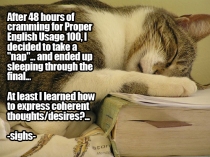Change of Pace

Devin and I have decided to open our own, more personal blogs where we can write about our own writing progress and process. We’d love for you all to follow us!
You can follow Devin at her blog or on twitter.
You can follow Jessie at her blog or on twitter.
We hope to see you around! We wish you a very happy holiday!
Sage Advice from Last Week
 I hope you all had a nice week off! Finals are over and we’re back in business–albeit, a bit late today. There was nothing recent that just resonated with me, so here’s an older blog post that I think is just as beneficial! When we’re all in the querying stage, this is the one thing we’ll need to pay attention to–I’m sure these Agent Pet Peeves apply to more than just the ones on the list.
I hope you all had a nice week off! Finals are over and we’re back in business–albeit, a bit late today. There was nothing recent that just resonated with me, so here’s an older blog post that I think is just as beneficial! When we’re all in the querying stage, this is the one thing we’ll need to pay attention to–I’m sure these Agent Pet Peeves apply to more than just the ones on the list.
Read and enjoy! (There’s even a part two.)
Finals Week!

Studying -- Hopefully NOT Us
Hello!
It’s finals week for Devin and me. We’ve been updating this blog everyday for two months (yay!) and we think it’s time to take a break! Okay, no… I was the one who decided to do this, but I’m sure Devin can agree with a break.
Because finals are important, and so is sleep (see right).
We need to study and be on top of our game and sometimes that means putting other things on the backburner for awhile. So we won’t be updating this week, but we will be back the following week!
See you Monday, December 13th!
Inspiration: Storms
Storms are one of those terrifying and magnificent natural occurrences. There are many types of storms: snow storms, ice storms, thunder storms, tornadoes, hurricanes, dust storms, the list could go on. And yes, while they can be destructive, they are beautiful in their own way. Storms are awe-inspiring.
Symbolism – Green!
Finally, one of my favorite colors, green! Green is associated with nature, rejuvenation and fertility, to jealousy, greed, and poison. Green is one of those colors that you just can’t get sick of. The sight of green for most people relaxes the mind and makes people feel at home. Why? Green symbolizes nature. Nature is comfortable for our brains, which in turn relaxes us. Kind of cool, right?
The positive:
- Green is relaxing, rejuvenating and safe.

Green Landscape
Like I said, green is the absolute most relaxing color for the human mind. Because it’s so relaxing–to our eyes, our minds and bodies–this color represents health. When plants are at their best, they’re a beautiful, rich green. Green is rejuvenating as well because it is a healing color. Sticking with nature, I’m sure we’ve all had a foray into a park or forest and came out for the better. Some might say it’s the fresh air and sun. It could be the green!
Again with nature references (most of the positive green ones have to do with it), fertility and green go hand in hand. This has to do with the goddesses of most mythology. The goddesses of the earth (here’s where nature comes in) almost always have to do with fertility as well. Not to mention the earth is probably the most fertile thing in existence that we know of.
The Negative:
- Green is jealous, greedy and sickly.
This is where green turns ugly. I’m not quite sure where jealousy and green became associated with each other–besides green and envy translating to jealousy. Greed however is obvious. Green often represents money, especially the American dollar. Greed is generally the excessive want of money, hence the association. As for sickly, we’ve all heard the expression “turning green.” This is because when we become sick, we get pale. When some people get pale–especially people with a more olive complexion–their skin will get a green tinge to it. Mind you, it’s very faint though!
Different greens mean different things:
- Light green is associated with freshness and springtime.
- Bright green shows health and vibrancy, particularly in nature.
- Dark green relates to ambition, greed and jealousy.
- Yellow-green indicates sickness, cowardice, discord, and jealousy.
- Blue-green is associated with emotional healing and protection.
- Olive green is the traditional color of peace.
Green is by far one of the most versatile colors out there. You can use it to describe youth and vitality, holiday cheer (since we’re getting close to that time, shoppers) and greed. Green is the one color you should use as much as possible, no matter what the circumstance. Anything and everything should have a touch of this emerald tone. Clothing, shoes, eyes, hair…. Everything! Fall in love with green and it’s going to stick around with you forever.
Lesson 21
Continuation from Lesson 20. Once again, my inspiration is fictionpress. Today, I did my usual reviews and I stumbled across a writer with a very unique way of sounding out words. I commend them for their creativity in spelling. However, we’ve got more important fish to catch.

Vocab Wizard
First things first; the almighty there, their, they’re. You’ve got to love the way English is, right? (We all know it’s the easiest language to learn, of course.) There is a direction. One trick you can use to remember this is by remembering other directional words, such as here and where. Of course, this method is problematic if you can’t remember those… but we’ll assume you can! Notice how here, there and where all end with “ere”. When going through the choices, just keep in mind that the word ending with “ere” is the one you need for direction. Ex: It is over there.
Their is possessive. The best way I can think of would be to just remember the other two and do a process of elimination, though it’s not very exciting.
They’re is the contraction of they are. Just like with the last lesson and it’s vs its, the easiest way to check if this is the right one is to break it down. If you go into the sentence and say, for example, “They’re coming to visit.” –> “They are coming to visit.” Simple as that!
Sticking with th words, let’s move onto through vs. threw. Most often when I’m looking over fiction press posts, I notice that these two get mixed up. It’s a common mix up, sadly. Threw is the past tense action of throwing. Example sentence in present tense: “He throws his baseball bat.” Past tense: “He threw his baseball bat.” Threw is a verb.
Through is where something/someone goes into something on one side and comes out the other. Ex: “We went through a tunnel.” Not much more to it, really.
Hope this clears up any confusion people might have had about some of these! There are more homophones out there that I could go over, but this is it for now.
The Voice of a Query
I’m not sure many people have talked about voice in a query, other than that it needs to be there. I’m no expert, but I may have a few tips to integrate your character’s voice into your query.

Falling in Love
What’s the advice?
Queries need to be written in a third person subjective point of view. This means that when you write, “she fell in love with him,” you’re using the exact same words your character would use to describe her budding feelings. Would she rather say, “she fell for him. HARD,” or would she say, “her feelings for him blossomed into love.”
The trick here is to mentally write your query in first person, using your character’s voice to write it through their viewpoint. Why can’t you just write the query in first person? Because your character didn’t write your book. A query in first person can be a gimmick and I’m sure a lot of agents don’t want a gimmick.
If you’re getting a lot of critiques saying your query sounds like a synopsis or a summary, try rewriting your query in first person to get at your character’s voice and how your character feels about what’s happening. Then switch it back to third person (which is pretty easy!) and you should see a difference.
Good luck!
Sage Advice from Last Week

Dive into a great book
Last week I read two great posts. One was from Guide to Literary Agents. Chuck has doing an “Agent Guest Column Month” for November and I found the guest column by James M. Tabor gave me a bit of an ah-ha moment. In it he points out that the best way to get a good start on writing is to go out and live your life.
It might seem like a silly thing, but I know that I have a tendency to delve into what I’m doing and I’ll forget about the outside world. I’ll put off cleaning my room or vacuuming the house to stay in front of the keyboard and hash out whatever I can of the next scene I’ve got. (Homework is my exception.)
I think that this advice is true. It wasn’t until a road trip with Jessie last summer that she and I began writing novels with the purpose of getting them published. Going out and seeing new sights can inspire and get the creativity flowing. At least, that’s the way it is for me.
What do you think? Does getting out of the daily grind inspire or damper your imagination?
Thanksgiving Exercise 5
Devin and I think writing outside of your story really helps improve your writing. We thought we’d change up the routine this week for Thanksgiving and show our thanks to our readers by offering short exercises to improve your craft.

Thanksgiving Food Coma
Today’s Thanksgiving Exercise is on description. Easy enough to do, right? Wrong. Description can easily turn into exposition, which is boring and dry. No one wants to read a page of exposition, especially about details in a house or in a forest that don’t even matter.
So, how do you describe without overkill? Pick the best details. This can be hard because when we write, we can sometimes see the whole thing in our heads. It’s hard to know what part of the room is the most important!
Here’s the exercise:
1. Research (yes, again). Read my posts on the science of description and how to set exposition between action. These two posts will help you with this lesson (in theory) and will inform you on what description is the best and most important for your story.
2. Create a scene where your characters are going on a journey. It doesn’t have to be through the forest, but it needs to rely on the actual process of getting from place A to place B. You can create new characters for this task to exercise your imagination or you can use a scene you have not written from your WiP that fills the requirement!
3. Prepare! This involves writing. Yes, before the actual writing. Write out the description of everything in the setting and scene exactly as you see it. Describe the color of the door handles, how dirty the grout between the tiles is, the color of the pine needles and the decaying leaves on the forest floor–every miniscule detail!
Here’s the writing part:
4. Write the scene, plugging in key details that you’ve already written down. Your task is to pick the best details that reveal the most about the scene as a whole (setting, character, tone, etc.). In any chunk of description, there shouldn’t be more than three sentences of pure description. Of course, the best way to introduce detail is to weave it between action. More importantly, description should be a part of the action; none of the describing sentences should have the ‘to be’ verb (was, are, were) in it.
This exercise should help you pick out what parts of the scene are necessary to reveal and when it’s necessary to reveal them. Good luck and feel free to post your exercises on your blogs or in the comments! I’d love to read what you come up with 🙂
Thanksgiving Exercise 4
Devin and I think writing outside of your story really helps improve your writing. We thought we’d change up the routine this week for Thanksgiving and show our thanks to our readers by offering short exercises to improve your craft.

Thanksgiving
Today’s Thanksgiving Exercise is on point of view. A lot of people think the trick to PoV is choosing between three options: first, second, and third. Guess what? Not true! After you pick that, you’ve got to choose between the level of penetration or how much you want readers to be inside your viewpoint character’s head.
So, how can you make the best decision for your PoV? The best example is to think about all of your options. Would your story be better told by this character or this one? Would it be better in first or third? Would your viewpoint character be more sympathetic with an objective or subjective standpoint?
Well, the best way to find out is to learn how to write from all of it.
Here’s the exercise:
1. Research. I know this isn’t school, but the best idea when you don’t know something is to learn about it! You need to know all of your point of view options in order to make the right choice about it for your book. Start with our easy descriptions of omniscient, limited omniscient, subjective, objective, and detached.
2. Pick from one of these two situations. Situation one: Two characters are looking for a turkey for dinner at the store. They both just watched a film on animal cruelty the week before. Situation two: One of your characters leaves the store, arms full of bags for Thanksgiving, and slips on the ice. Your character gets up to look around and notices another one of your characters watching with interest.
Create new characters from any of your other stories or WiPs for this task to exercise your imagination!
Here’s the writing part:
3. Write the situation you choose while narrating their thoughts and feelings without using dialogue (you can use a maximum of 7 lines of dialogue). You must convey the situation in three different ways. First, write it from single character subjective from the first character’s point of view (in first or third person). Next, write it in single character subjective from the second character’s point of view (in first or third person). Write the last one in objective PoV or omniscient PoV.
Take only half-an-hour to an hour to complete each version. They don’t need to be complete, they don’t need to be fancy; they just need to be there. Compare each version and decide whose point of view tells the story better. This task will show you how many choices you can make for telling your story 🙂
Feel free to post your exercises on your blogs or in the comments! I’d love to read what you come up with 🙂

I'm a freak for using this, but it sparkles! And is therefore awesome!




